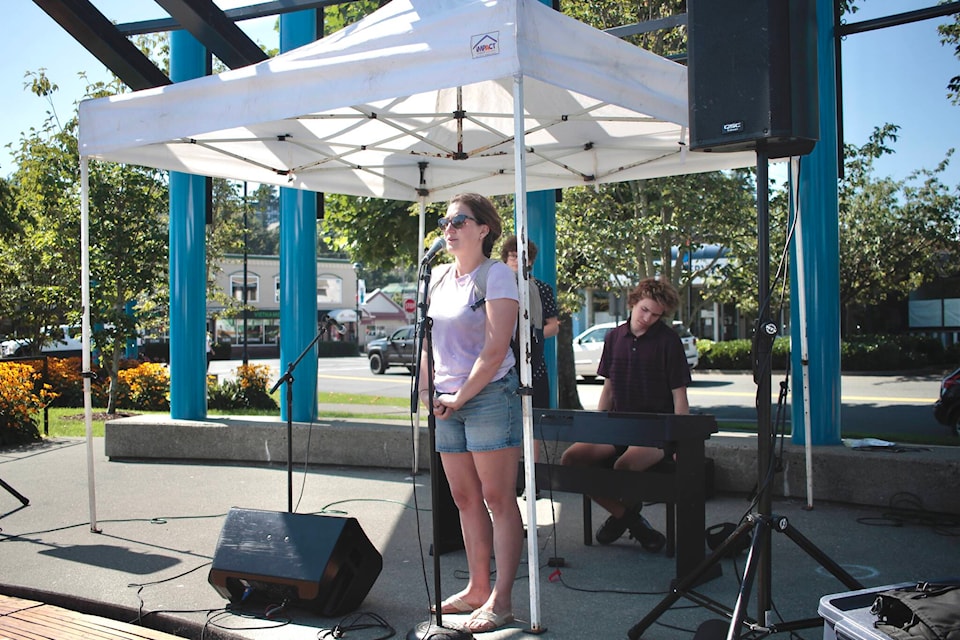It has been six years since the B.C. government declared the toxic drug crisis a public health emergency, and in the first four months of the year 10 Campbell Riverites have died due to drug toxicity.
To remember and recognize those lives that have been lost to the crisis in Campbell River, an International Overdose Awareness Day (IOAD) event was held on Aug. 31 in Spirit Square.
“We see the loss almost daily, and everybody feels it,” said Gwen Donaldson, coordinator of the Community Action Team (CAT) in Campbell River. “In the first four months, we have lost ten people… We’re just encouraging everybody to remember and recognize the lives that have been lost to this crisis in our community.”
The event included a number of community partners including the Campbell River Art Gallery, which had staff on site showcasing the artwork of local unhoused people.
Vancouver Island Mental Health Society was also on site with their new drug checking machine, which uses spectroscopy to determine which chemicals are present in a given sample. The service is offered on Tuesdays and Fridays between 1 p.m. and 5 p.m. at the Overdose Prevention Site at 1330 Dogwood. Samples are tested for fentanyl and other substances on site, and then data captured using light is sent to Substance Drug Checking in Victoria for more in-depth analysis. Within 15 minutes the results are returned. VIMHS was also asking people at the event where they would like to see the service offered, including some potential locations where snap decisions are made.
Despite these organizations’ efforts, there are still gaps in the system. Jen Booth recently lost her son, aged 17, to drug toxicity.
“It’s pretty fresh,” she said. “I don’t think there’s a very good connection between people who are using and the services that we have. There’s a big disconnect. There’s very little help, and the stigma is still a big part. I honestly don’t think… there’s a bit more awareness thanks to people like Gwen and the other communities around here, but it’s still a very taboo subject.
“There’s not much support.”
Donaldson would like to see the province enact a “true emergency response.”
“I feel like most of us operate on a shoestring, most of us operate in silos and this is piecemeal. We haven’t seen a comprehensive mobilzation of the resources to deal with this crisis,” she said. “We need recovery services, we need safe supply, we need housing, social supports… we just have massive deficits everywhere in a massively fragmented system.”
In the meantime, the main thing Donaldson and Booth suggest is working to reduce the stigma around conversations about drug use.
“Be open to talking about substance use with your friends and family. Get naloxone training, even if you don’t think people in your life are using,” Donaldson said. “Really try to carry with you an openness, so that if anybody in your life is using in secrecy, maybe they can feel like they can talk to you about it.”
“My son passed away at home. It can happen to anybody,” Booth said. “It’s not just people who are homeless, or people who don’t have money. All these people have families. They’re someone’s brother, uncle, son… Just be kind and try to have an understanding of what people are going through.”
More information on the Drug Checking program can be had by calling 250-895-1825. The Campbell River Overdose Prevention Site is located at 1330 Dogwood Street. More resources for people who use drugs or who have family who use drugs can be found at the Community Action Team website: www.communityactioncr.ca/ops.
RELATED: Black Balloon day commemorates those lost to toxic drug crisis
B.C. sees record high 1,095 toxic drug deaths in first 6 months of 2022
marc.kitteringham@campbellrivermirror.com
Like us on Facebook and follow us on Twitter
